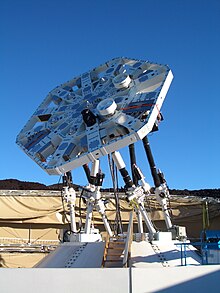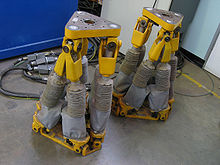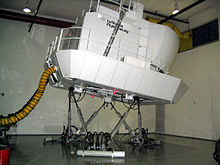史都华平台


史都华平台是有六个棱柱接点的并联式机械手,其棱柱接点多半是油压或是电子式的线性致动器,两两成对装在平台的三个位置。棱柱接点的下方也是两两成对接在平台底盘的三个位罝,但配对会和平台的配对错开。六个棱柱接点两端共12个接点,都是用万向接头连接。史都华平台上方的物体的移动有六自由度,包括三个方向的移动,以及三个方向的转动
史都华平台有许多其他的名称。在包括飞行模拟的许多应用中,会将史都华平台称为运动平台(motion base)[1]。有时也会称为是六轴平台或六自由度平台,原因是因为其可能运动的自由度,其自由度是因为多重致动器的组合而成。史都华平台也可以称为协同运动平台(synergistic motion platform)因为致动器在规划上需要协同作业。因为有六个致动器,也会称为是hexapod,这个名称最初是Geodetic Technology公司针对机床上使用史都华平台的商标[2][3]。
历史

配置六个致动器的史都华平台最早是由英国的Eric Gough使用,在1954年开始运作[4],后来在1965年由在史都华(D Stewart)提交给英国机械工程师学会的论文中发布[5]。1962年时,美国工程师Klaus Cappel独立发明史都华平台,时间在史都华的论文之前。Klaus将此设计申请专利,授权给第一家飞行模拟公司,建造了第一个商业贩售的八面体史都华平台运动模拟器[6]。
此一机械的名称常称为“史都华平台”,也有些人认为"Gough–Stewart platform"的名称比较合适,因为史都华的原始设计其实有一些差异[7],也有些人认为三位发明此机械的工程师都应该被提到[6]。
致动器
线性致动器
工业应用的史都华平台,常会使用线性的液压致动器,因为有简单且唯一逆运动学的解析解,而且其强度以及加速度特性良好。
转动致动器
应用
史都华平台已用在飞行模拟器、机床机床、机械偶、吊车、海底研究、地震模拟、卫星天线定位、史都华平台望远镜、机器人、骨科手术应用中。
飞行模拟器

史都华平台常用在飞行模拟器中,特别是需要六个自由度的全飞行模拟器。此应用是由Redifon公司发展的,其模拟器在1962年时可以用来模拟波音707、麦道DC-8、卡拉维尔客机、卡拉维尔CL-44、波音727、维克斯子爵、维克斯先锋型、康维尔990、C-130运输机、维克斯VC10及福克F27等飞机[9]。
在飞行模拟器应用中,史都华平台的酬载包括复制的座舱以及视觉显示系统,一般会有数排,模拟受训飞机机组人员在飞机上会看到的场景。若是大型运输机的全飞行模拟器,酬载会到15,000公斤。
类似的平台也用在驾驶模拟器中,一般会装设在大型的X-Y平台上,以模拟短程的加速。长程的加速会透过车辆往前或往后的倾斜来达成,目前也有研究在探访如何合并这两种效应。
Robocrane
国家标准技术研究所(NIST)的James S. Albus开发了Robocrane,平台不是放在六个致动器上,是用六个缆线悬吊支持。

LIDS
NASA开发的低冲击对接系统(Low Impact Docking System)使用了史都华平台模拟太空船对接时的动作。
CAREN
Motek Medical发展的电脑辅助复健环境(Computer Assisted Rehabilitation Environment,简称CAREN)配合了虚拟现实来进行进阶的生化及临床研究[10]。
泰勒空间框架
查尔斯·泰勒博士用史都华平台开发了泰勒空间框架[11],是用于骨外科手术的外固定器,用来矫正骨骼的变形及治疗复杂骨折。
力学试验
史都华平台最早的机械应用是由Eric Gough用在机械试验上,Eric Gough是车辆工程师,在英国伯明翰的登禄普轮胎工厂工作[12]。他在1950年代发明了“通用轮胎测试机”,设备在1954年运作(Universal Tyre-Testing Machine)" (also called the "Universal Rig") in the 1950s and his platform was operational by 1954.[4]。测试机可以合并不同负载进行输胎的力学测试。Gough在1972年过世,其测试机一直运作到1980年代末期,直到工厂结束营运拆除为止。测试机保留下来,运到伍顿附近科学博物馆的储藏中心。
在90年代末期,研究人员再度对史都华平台的机械测试机有兴趣[13],可以应用在生医的领域(例如脊柱研究[14]),原因是要克隆人类及动物复杂及大幅度的运动。在木土工程领域的地震模拟中也有类似的需求。可以用全领域的动力量测算法控制此机器,用来研究刚性样品上的复杂现象(例如裂纹在混凝土块上的传播[15]),测试设备需要可以承受大的负载,而且要可以精确的位移。
相关条目
- 执行器
- 线性致动器
- 并联机构
- 机器人运动学
参考资料
- ^ Becerra-Vargas, Mauricio; Morgado Belo, Eduardo. Application of H∞ theory to a 6 DOF flight simulator motion base. Scientific Electronic Library Online. Journal of the Brazilian Society of Mechanical Sciences and Engineering. [24 January 2020].
- ^ Parallel Robots - Second Edition by J.P. Merlet (p. 48)
- ^ Fraunhofer Research: Hexapod Robot for Spine Surgery (PDF). [2005-12-16]. (原始内容存档 (PDF)于2005-12-16).
- ^ 4.0 4.1 Gough, V. E. Contribution to discussion of papers on research in Automobile Stability, Control and Tyre performance. Proc. Auto Div. Inst. Mech. Eng. 1956–1957: 392–394.
- ^ Stewart, D. A Platform with Six Degrees of Freedom. Proceedings of the Institution of Mechanical Engineers. 1965–1966, 180 (1, No 15): 371–386. doi:10.1243/pime_proc_1965_180_029_02.
- ^ 6.0 6.1 Bonev, Ilian. The True Origins of Parallel Robots. [24 January 2020]. (原始内容存档于2020-07-04).
- ^ Lazard, D.; Merlet, J. -P. The (true) Stewart platform has 12 configurations. Proceedings of the 1994 IEEE International Conference on Robotics and Automation. 1994: 2160. ISBN 978-0-8186-5330-8. doi:10.1109/ROBOT.1994.350969.
- ^ Robert Eisele. Inverse Kinematics of a Stewart Platform. [2019-04-15]. (原始内容存档于2020-11-26).
- ^ 1962 | 1616 | Flight Archive. [2020-12-11]. (原始内容存档于2016-03-06).
- ^ Computer Assisted Rehabilitation ENvironment (CAREN). [2020-12-11]. (原始内容存档于2015-09-05).
- ^ J. Charles Taylor, M.D.. [2020-12-11]. (原始内容存档于2020-12-02).
- ^ Tompkins, Eric. The History of the Pneumatic Tyre. Dunlop. 1981: 86, 91. ISBN 978-0-903214-14-8.
- ^ Michopoulos, John G.; Hermanson, John C.; Furukawa, Tomonari. Towards the robotic characterization of the constitutive response of composite materials. Composite Structures. 2008, 86 (1–3): 154–164. doi:10.1016/j.compstruct.2008.03.009.
- ^ Stokes, Ian A.; Gardner-Morse, Mack; Churchill, David; Laible, Jeffrey P. Measurement of a spinal motion segment stiffness matrix. Journal of Biomechanics. 2002, 35 (4): 517–521. CiteSeerX 10.1.1.492.7636
 . PMID 11934421. doi:10.1016/s0021-9290(01)00221-4.
. PMID 11934421. doi:10.1016/s0021-9290(01)00221-4.
- ^ Jailin, Clément; Carpiuc, Andreea; Kazymyrenko, Kyrylo; Poncelet, Martin; Leclerc, Hugo; Hild, François; Roux, Stéphane. Virtual hybrid test control of sinuous crack (PDF). Journal of the Mechanics and Physics of Solids. 2017, 102: 239–256 [2020-12-11]. doi:10.1016/j.jmps.2017.03.001. (原始内容存档 (PDF)于2018-07-28).
延伸阅读
- Bonev, I.A., "The True Origins of Parallel Robots(页面存档备份,存于互联网档案馆)", ParalleMIC online review
外部链接
- Picture of the NIST/Ingersoll prototype octahedral hexapod (页面存档备份,存于互联网档案馆)
- Hexapod Structures for Surgery
- Hexapod for Astronomy (页面存档备份,存于互联网档案馆)
| ||||||||||||||||||||||||||||||||
Text is available under the CC BY-SA 4.0 license; additional terms may apply.
Images, videos and audio are available under their respective licenses.
